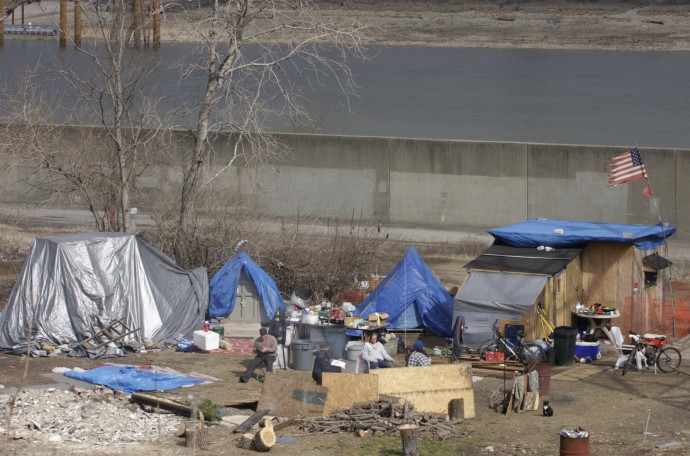
ST. LOUIS (AP) — Sometimes the men emerge from out-of-town police cruisers that stop at homeless shelters and then quickly drive off. Others turn up still wearing gowns from suburban hospitals.
Surrounding communities have long been accused of using downtown St. Louis as a dumping ground to dispose of homeless men with nowhere else to go. But as the weak economy and foreclosures push more people onto the streets, overwhelmed city officials say enough is enough. They want outsiders to start taking care of their own.
“It’s a big problem,” said the city’s human services director, Bill Siedhoff. “It’s one we’ve talked about for a long time. There’s just been no response from these surrounding areas. They think it’s fine for the city to pick up this responsibility and for them to contribute nothing.”
Suburban leaders are offended by the complaints, which they insist are based on a myth.
“For anybody in the city of St. Louis to suggest that we are shipping our homeless people into the city and letting them fend for themselves — they know that’s an untruth,” said Mac Scott, a spokesman for St. Louis County Executive Charlie Dooley.
Experts say the suburban homeless population is rising. Shelters in St. Louis are virtually full all the time.
Homeless advocate Larry Rice, a pastor who operates a shelter at his downtown New Life Evangelistic Center, said he typically housed 200 to 225 homeless last year.
“Now, it’s not unusual to have 300 to 325, and the difference is people coming from outside of St. Louis,” Rice said.
St. Louis has a homeless population of a little over 1,300 people on any given day, Siedhoff said. The homeless in surrounding counties number about 700. But while those counties have shelters that serve abused women or mothers with children, there are few agencies offering help to men, except in the city.
Last week, Rice went to Belleville, Ill., to call attention to the problem. He picked up Belleville people he said had been dropped off across the Mississippi River in St. Louis and brought them back to Illinois. He called for the community to come up with a better way to address homelessness.
Belleville Mayor Mark Eckert said Rice is simply wrong. He said the struggling economy has led to an increase in homelessness. And while some people from Belleville may go to St. Louis seeking shelter, Eckert said his city neither encourages them to leave nor dumps them downtown.
“We would never transport somebody to another shelter out of town,” Eckert said.
Many make their way to St. Louis on their own or with the help of friends, the mayor said.
But Rice’s son, Chris, also a pastor at New Life, said he has seen police vans pull up near his center, watched officers remove handcuffs and then leave homeless men in a park across the street.
Larry Rice said suburban hospitals and detox centers have also been known to bring homeless people into the city and leave them near shelters — sometimes still wearing hospital gowns.
“They don’t know what to do with them in these other municipalities,” Larry Rice said. “They don’t have any shelters.”
Siedhoff said he recently interviewed 61 people staying at a homeless encampment along the St. Louis riverfront.
“None of those people were from the city of St. Louis,” he said. But when an Associated Press reporter and photographer visited the encampment this week, all of the two dozen or so people interviewed said they were there on their own.
St. Louis’ largest homeless services provider, the St. Patrick Center, said in a statement that it has not witnessed any dumping trend.
Suburban leaders say it isn’t unusual for transient people seeking shelter to make their way to the city because they know they’re more likely to find shelter and assistance there, not because of a concerted effort to drop them off or shoo them away.
“If anyone is being dropped off in St. Louis, it must be by private citizens,” said Dottie Kasgigar, homeless services coordinator for three nearby counties. “I personally think the allegations are false. We just have no evidence to support it.”
In fact, suburban officials say, since the economic collapse of 2008, the problem has grown in outlying communities. But they don’t have the money to adequately address homelessness.
Kasgigar said her region receives the same amount every year — about $227,000 — for homeless programs even though the homeless population is rising sharply, topping 100 for the first time in 2010, the last year for which figures are available.
St. Louis County spends $3.5 million annually on homeless services.
“The funding has not followed the problem,” Kasgigar said. “Suburban communities are left to struggle on their own.”
There are no shelters for men in Kasgigar’s three counties, but churches in the region have set up a fund that pays for a hotel room for those in need of temporary housing. Programs are also available to help counsel them, she said.
Belleville-area churches provide similar assistance. Eckert said the town’s only shelter for homeless men, operated by the Salvation Army, closed in 2010.
Officials on both sides of the issue agree on at least one thing: They should discuss solutions. Eckert suggested suburban areas consider adopting a regional approach to the problem. Siedhoff is thinking of calling for a regional summit.
“I just think it’s a matter of reaching out to leaders of these counties and communities to think about homeless people,” he said.


